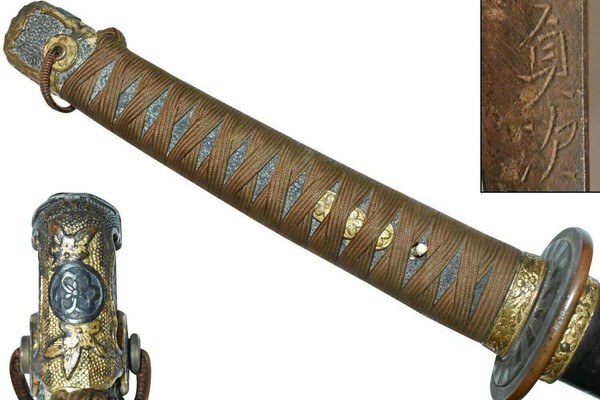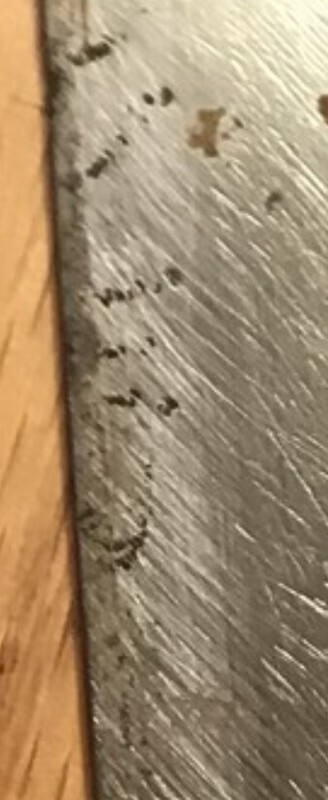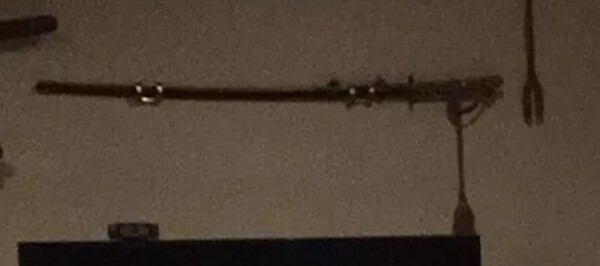-
Posts
13,067 -
Joined
-
Last visited
-
Days Won
157
Content Type
Profiles
Forums
Events
Store
Downloads
Gallery
Everything posted by Bruce Pennington
-
A mind is a terrible thing to waste! Sorry if I've posted this one before, but I don't remember asking for help on this one yet. The stamp was poorly struck, so there's some strokes missing. Any idea of the meaning? Thanks!
-
Couldn't find a family name tied to this, but it seems to be a variation of the Oxalis plant theme. Found on a kaigunto HERE
-

Brass Scabbard NCO Copper Handle
Bruce Pennington replied to IJASWORDS's topic in Military Swords of Japan
Neil, That is the most completely colored one I've seen before. I seem to have missed that discussion in F & G! I tried to find our earlier discussion about the gold coloring of the copper-handled sayas, with no luck. I wonder if this is different than the faint gold that seems to be on many of the copper-handled 95 saya? Here's mine. Also, this re-opens my questions, years ago, about gold-painted saya. I know you said this is gilding, not paint, but maybe some of the others that are painted are simply trying to emulate this style finish? -

Survey on distribution of Mon
Bruce Pennington replied to PNSSHOGUN's topic in Military Swords of Japan
-

Show Us Your High Class Gunto
Bruce Pennington replied to lonely panet's topic in Military Swords of Japan
Quite beautiful, Alexander. Clearly custom fittings. Do you know the significance of the hot stamp at the end of the nakago? Do you know who the smith might have been? -
David, It's an interesting proposal. You'll notice all the Matsu stamps are from the beginning of the RJT program, 1942, through 1943. So far, we have no Matsu in 1944 or 45. But we do have katakana. So, you're idea would work if the industry supply of matsu-zumi was out or severely limited by that time. The katakana could indicate a different charcoal was used. The purists of IJA regulations regarding RJT ops, might balk at the idea. All three blades we have with katakana are also star stamped. However, we have already seen that mil-specs on sword fittings, even sword quality was allowed to drastically veer from the regs at the end of the war, so I wouldn't rule the idea out of a blade rating a star even if non-regulation charcoal was used in 1944/1945.
-
You might ask him if he would let you work with him personally, not publicly. I have been pestering him and Steve (Shamsy) to publish a book on their experience with the Type 95, so maybe he doesn't want to go public with his data yet. But I have personally found that having more people working on a study, brings more data and breakthroughs that weren't available to me working alone. So, I'd approach it that way to see if the two of you, together, could enhance his knowledge-base.
-
-
When I started my stamp survey, I found out that Fuller and Cox had both very large surveys done before me. I stayed with it, and it has still proven useful to me. The graph that I made up shows a visible flow over time of the stamps that was not available in their surveys. Plus I discovered something new, due to current internet sales.
-

My first Shin Gunto, Type-95 NCO
Bruce Pennington replied to hale1940's topic in Military Swords of Japan
If you look at the top, under "Japan News" you'll see a Home button. Click that and you'll find all sorts of interesting forums, here at NMB. One of them is "Nihonto" where the traditionally made blades are most often discussed. Military gunto had a variety of blades in them, from ancestral, real Samurai, to "modern" nihonto, through the gamut of factory blades. I'm posting a list of 9 ways Fuller categorized the military blades. Some of the fun of hunting WWII gunto, is hoping to find a gorgeous, old, nihonto that had been re-fitted for the war. I decided to collect a fair representative of each of the branches (army, navy) and officer/NCO, plus a few of the pre-WWII gunto. My favorite are the Mantetsu blades. -

My first Shin Gunto, Type-95 NCO
Bruce Pennington replied to hale1940's topic in Military Swords of Japan
Welcome Hale! Nice start on a long-term hobby. Have you discovered the Ohmura pages? http://ohmura-study.net/957.html Also worth you money to pick up the Dawson Book and the Fuller & Gregory Book. They are foundational reference books on all the Japanese war swords since the modernization. -

Katana Signature Assistance Please
Bruce Pennington replied to LionsFan's topic in Translation Assistance
Dark pictures, but correct me if I’m wrong, but no screwdriver slot in the head? And no threads at the end of the bolt? I will edit this later if I find out differently, but I’m pretty sure those bolts and nuts were brass. Not Steel. So this still points toward post war work.- 31 replies
-
- katana
- restoration
-
(and 1 more)
Tagged with:
-

Katana Signature Assistance Please
Bruce Pennington replied to LionsFan's topic in Translation Assistance
If the blade was made by a type 95 process, there would not be much to bring out with a polish. The zoheito (factory blades) were hardened but had no hamon (fancy temper line). if it were mine, I would hang onto it and not discard it. We have come across strange things over the past few years that we thought were postwar Bubba jobs, and learned later that they were legitimate or time work. I have learned that the hard way with one of my Swords!- 31 replies
-
- 1
-

-
- katana
- restoration
-
(and 1 more)
Tagged with:
-

Katana Signature Assistance Please
Bruce Pennington replied to LionsFan's topic in Translation Assistance
I don't think any of the parts of this gunto are reproductions, all legit Japanese sword stuff. The only question is WHEN were the things done to this that were done. I wish we had more clear pics of that tsuka bolt. From the fuzzy seller picture, it seems to me to be the original Type 95 bolt, with the nut-end bludgeoned flat, and the patina looks quite old. Yet, the sanding or grinding of the area where the nakago was modified seems quite new. So, all real Japanese sword parts, but a mystery as to whether someone modified this blade for an NCO during the war, or someone post-war did this work. I don't know, metallurgically, why a blade doesn't rust, yet the nakago does - NEIL???? - could the affects of welding on a nakago create the conditions in the steel to keep the area free of rust? Another issue remaining is the off-set machi. I am aware of examples of officer gunto with what appears to be a blade made by a Type 95 producer, sometimes with bo-hi, sometimes not, and no serial numbers. It was obviously made for the officer, due to sword shortages, by a 95 maker. The blade on this could be explained that way. It still leaves the question as to "when" the old nakago was attached, and why. In the threads about the sword repair teams, it was told that the majority of sword damage brought to the team was tsuka damage. To me, this leaves open the possibility that this gunto was damaged and a repair team slapped on another nakago & tsuka. But like Occam's Razor, the simplest answer may be the correct one - post-war piece-together!- 31 replies
-
- katana
- restoration
-
(and 1 more)
Tagged with:
-
There's another blade being discussed HERE that has multiple lines like this, same cross-the-blade direction. There must be a metallurgical explanation for these.
-

Katana Signature Assistance Please
Bruce Pennington replied to LionsFan's topic in Translation Assistance
Luke, Can you get a look in the "new" hole that was drilled to fit the tsuka (handle)? Is there some good rust, like 80 yr old rust, in it, or is it new looking? Thirdly, did you clean that area where the nakago joins the blade, or was that already like that when you got it? On another topic, I find the pitting on the blade interesting. It reminds me of that other blade we were discussing recently where the guy said it reminded him of a famous treasure map. I wonder what causes that type of pitting?- 31 replies
-
- katana
- restoration
-
(and 1 more)
Tagged with:
-
Well, this has been a learning experience for me! Thanks Trystan!
-
Never seen one like it! Glad you brought to the forum. It’s going into the files now!
-

Katana Signature Assistance Please
Bruce Pennington replied to LionsFan's topic in Translation Assistance
NCOs had been known to carry ancestral blades since WWI. We also are aware of a 1945 official order permitting them to do so. But the few pictures of them doing so are showing civil tsuka/tsuba mounted in leather covered saya (like this one), rather than the Type 95 tsuba/tsuka. This is the first I've ever seen, but as we all know with WWII gunto - never say never or always! I'm curious about the machi being offset on this blade. WWII-made officer blades always have aligned machi, and NCO blades are always offset, but I thought (forgive my ignorance) that nihonto always had aligned machi. Also, maybe it's the angle of the photo, but this nakago looks crooked, like it was welded onto a blade that had a broken nakago. Anybody else see that?- 31 replies
-
- katana
- restoration
-
(and 1 more)
Tagged with:
-
Stephen, I can't read mei .... what am I seeing here? I searched the kanji you translated and it leads to Kokura Army Arsenal discussion. Is this mei saying "Kokura Army Arsenal"?????? I've seen two blades with sword shop mei, but I don't think I've ever seen this, if that is what it's saying!
-
Here it is Trystan. At the time I started it, most people were calling them Navy landing forces sword. https://www.militaria.co.za/nmb/topic/22400-nlf-gunto-discussion/?tab=comments#comment-227100
-

Japanese Type 95 Sword for NCOs
Bruce Pennington replied to Shamsy's topic in Military Swords of Japan
I mentioned on another thread, somewhere, that I felt the Quality Control at the Tokyo Arsenal was tighter than that of the Nagoya Arsenal. I don't remember what part of the gunto I showed at that time, but today I was looking at the bo-hi of each, and the starting-point is cleaner and more uniform on the Tokyo blades than it is on the Nagoya blades. I even have one Nagoya blade where the bohi starts at the habaki edge on one side, but is off-set on the serial number side. Some examples: Tokyo Nagoya -

Show Off Your Gunto Display
Bruce Pennington replied to IJASWORDS's topic in Military Swords of Japan
Matthew, What is that skinny, straight gunto? My first guess would be a child sword, but it has a tassel, and the blade seems as long as the adult gunto above it. -
-
I'm sure it was a terrible time. In the year-long bombing campaign we were damaging their factories to the extent that they started farming out their production more and more to the Jensen Arsenal and China-based operations.















